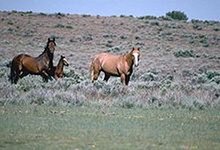Horses evolved as wandering herbivores, moving slowly for hours and taking bites of whatever forage they came across. Modern feeding practice is quite different, with many horses given all-day access to rich forage, contributing to high rates of obesity.

Wild horses in the Utah desert
The horse's digestive system works best when small quantities of food are ingested almost continuously.
Other horses are confined to stalls and given two or three large grain meals each day. Between flakes of hay with a high carbohydrate content, there are often long hours when these horses have nothing to eat. It's no surprise, then, that metabolic problems and gastrointestinal upsets are quite common in todayâs horses.
Horse owners and managers are listening to equine nutritionists who advise a return to a more natural management system. Simply stated, a better system will offer grain and forage over many hours, but the horse will be able to access only a small amount at a time.
Acquiring the necessary devices and teaching your horse to use them will pay off in the long run, and your horse will likely avoid colic, gastric ulcers, obesity, and the stable vices that spring from boredom.
To decrease forage intake for horses that are out on pasture, follow one of these tips:
- Use a grazing muzzle. These devices have small holes in the end so horses can eat, but the amount that they get in each bite is restricted.
- Put the horse in a stall or drylot for part of each day. A drylot allows room for the horse to exercise, but he can eat only what you provide instead of gorging on grass.
There are a number of devices designed to decrease speed and amount of hay consumption. An Internet search will turn up a variety of ingenious styles including nets, boxes, barrels, and tubs that hold a lot of hay, so they donât have to be filled too frequently.
The idea behind all of the devices is the same: bars, ropes, or nets block direct access to large mouthfuls of hay. The horse can pull out only small bits at a time, mimicking natural feeding behavior and keeping the horse interested and occupied for hours.
To slow grain consumption, available devices range from dispensers that dribble grain out a few pellets at a time to large, heavy ground feed tubs with a series of shallow wells. Each well holds only a little grain and the horse has to work to find and eat all the grain.
Other feeders are in the form of a large plastic ball or barrel with holes spaced around the perimeter. The horse noses the feeder around, eating the pelleted or cubed feed that falls out of the holes. Like the restricted hay feeders, these grain feeders keep the horse occupied for long periods of time and prevent grain from being gobbled too quickly.
Like anything else designed to be used around horses, the feeders you select need to be built of sturdy materials that will not splinter or break. Inspect the devices frequently for proper operation, excessive wear, and sharp corners.
Look at the designs with an eye toward your particular horse and his surroundings. If he wears a halter, could it get caught on the feeder? If he is shod, could he catch a shoe in a feeding net or bag that is designed to lie on the ground or stall floor? Home-built copies of popular slow feeders should be carefully thought out, constructed of heavy-duty materials, and routinely examined for safety.
Reprinted with permission of Kentucky Equine Research
